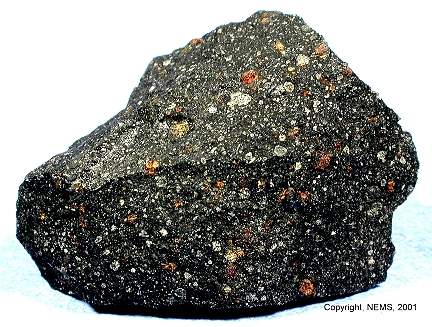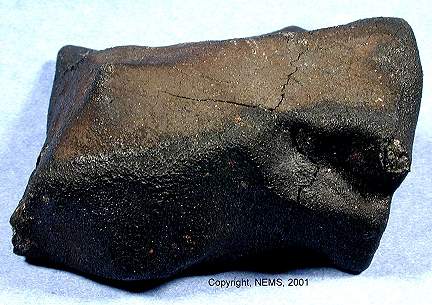|

February, 2001 |

|
|
Allende and Murchison
Published images of two of the most notable carbonaceous
chondrites
We all know the adage "...there is no time more productive than
the 11th hour". Whether it's an Abstract needed to summarize a paper or the
final draft for publishing, it's the "11th hour" when it all happens.
1:20 P.M., January 3, 2001.
Discover Magazine called with a request for photo support for an
upcoming article by Phillip Bland about carbonaceous chondrites and their
(direct?) descendancy from nebular processes. However, Discover only had images
of ordinary chondrites, not carbonaceous ones.
"The March issue closes today, could we provide suitable images,
via email attachments, in two hours?" !!!!!! That old 11th hour again - for
them and us.
We got the job done, emailed the images, and they were used in the
March 2001 issue. Unfortunately, Discover Magazine didn't have enough space
within the article to present the images to their full resolution - so here
they are.
Camera, Nikon D1. Image processing, Adobe Photoshop 6.0. The
images are presented in two formats - compressed jpeg and hi-res jpeg.
Additionally, super hi-res tif files are available for publications. The hi-res
and tif files are large but the resolution detail is well worth the time spent
in downloading.
Compressed jpeg, 1.6 kilo, fusion-crusted Allende. Note the
contraction cracks throughout the crust.

Hi-res jpeg 1.79 meg
Compressed jpeg, 23 gram fragment, Murchison.

Hi-res jpeg 1.6 meg
122 gram, whole specimen, Murchison

Hi-res jpeg 1.05 meg
The Allende and Murchison Falls both produced large amounts
>2000 kg and >100 kg respectively of meteorites - carbonaceous chondrites
- for study. Allende fell in Chichuahua, Mexico on February 08, 1969 and is
classified as a CV3 (Vigarano group, type 3)
Murchison fell on September 28 of the same year, 1969. It is
classified as a CM2 (Mighei group, type 2)
|
|
|
This document maintained by
staff@meteorlab.com.
Material
Copyright © 2001 New England Meteoritical Services. Index
|
Online Casino Win in Bangladesh: Your Ultimate Guide to Fun and Rewards
The online casino scene in Bangladesh is growing fast, with Win Casino at the top.If you love gaming and want to try your luck, https://win-bd-live.com/ Win Casino stands out as a great pick.Offering simplicity, safety, and non-stop entertainment,Win Casino is hard to beat.
Benefits of Playing at Win Casino
This platform ensures fun and seamless gameplay.From classic slots to live dealer games,it caters to every player.The site is easy to navigate, even if you're new to online gaming.
Massive Variety of Games
There are countless games waiting for you:
Slots, blackjack, roulette, poker – all available.Live casino games with real dealers for an immersive experience.
Safe and Secure
Win Casino ensures high-level protection.State-of-the-art security keeps your information and funds safe.You can focus on playing without worrying about safety.
Hassle-Free Transactions for Players
Depositing and withdrawing money is simple.You can use popular Bangladeshi payment methods here.Fast withdrawals mean you get your winnings quickly.
Exciting Offers at Win Casino
Win Casino provides amazing promotions:
Generous sign-up bonuses for newcomers.Ongoing deals such as free spins and cashback.
Check the promos page often for new offers.
Seamless Mobile Play Anytime
Love mobile gaming?Win Casino works perfectly on mobile devices.On your smartphone or tablet,you can enjoy your favorite games anytime, anywhere.
Quick Guide to Sign Up
Getting started is easy:
Access Win Casino online.Sign up with your details.Add funds to your account.Choose your game and begin!
Tips for Success
Keep a budget and follow it strictly.Explore various games to see your favorites.Rest between games for better focus.
Top Features of Win Casino
Win Casino stands out for its user-friendly platform, secure transactions, and exciting game variety.Bangladeshi players seeking entertainment and rewards find it ideal.
Why Choose Win Casino in Bangladesh
For online gamers in Bangladesh, Win Casino is a top pick.All you need for the perfect gaming session is here.Looking to test your luck?Join Win Casino now and start your winning streak!
Disclaimer: Gambling involves risk. Play responsibly.




